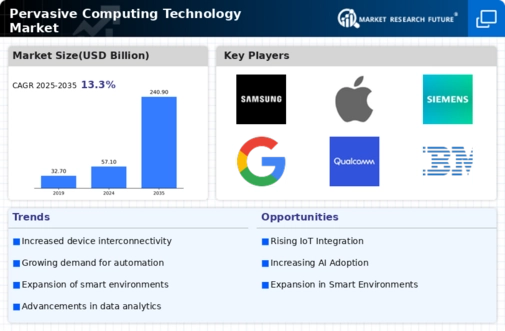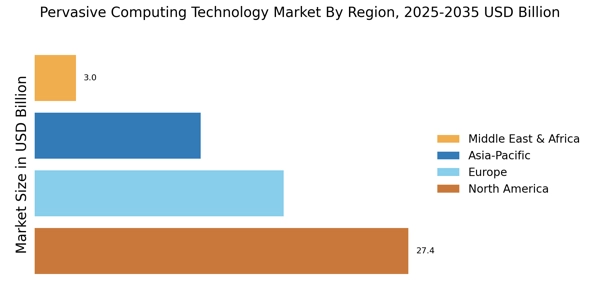Rise of Edge Computing
The rise of edge computing is significantly influencing the Pervasive Computing Technology Market. By processing data closer to the source, edge computing reduces latency and bandwidth usage, which is crucial for real-time applications. This trend is particularly relevant in sectors such as manufacturing and transportation, where timely data processing is essential for operational efficiency. The edge computing market is anticipated to grow at a compound annual growth rate of over 30%, reaching around 15 billion dollars by 2025. This growth suggests that businesses are increasingly adopting edge solutions to enhance their pervasive computing capabilities, thereby driving the overall market forward. As organizations seek to optimize their operations, the integration of edge computing into pervasive systems is likely to become more prevalent.
Emergence of 5G Technology
The emergence of 5G technology is poised to transform the Pervasive Computing Technology Market by enabling faster and more reliable connectivity. With its high-speed data transfer capabilities, 5G facilitates the seamless operation of numerous connected devices, which is fundamental to pervasive computing. The rollout of 5G networks is expected to enhance the performance of applications such as augmented reality and smart city initiatives. Market analysts predict that the 5G infrastructure market will reach approximately 50 billion dollars by 2026, indicating a robust investment in this technology. As 5G becomes more widespread, it is likely to catalyze further innovations in the Pervasive Computing Technology Market, driving the adoption of advanced applications and services.
Advancements in Sensor Technology
The Pervasive Computing Technology Market is experiencing a notable surge due to advancements in sensor technology. These innovations enable devices to collect and analyze data more efficiently, facilitating seamless integration into everyday environments. For instance, the proliferation of smart sensors in various applications, such as healthcare and smart homes, is projected to drive market growth. According to recent estimates, the sensor market is expected to reach a valuation of approximately 200 billion dollars by 2026. This growth is indicative of the increasing demand for interconnected devices that enhance user experience and operational efficiency. As sensor technology continues to evolve, it is likely to play a pivotal role in shaping the future landscape of the Pervasive Computing Technology Market.
Increased Demand for Smart Devices
The Pervasive Computing Technology Market is witnessing increased demand for smart devices, which are integral to the concept of pervasive computing. As consumers become more accustomed to technology that enhances convenience and connectivity, the market for smart devices continues to expand. Recent data indicates that the smart home market alone is projected to exceed 100 billion dollars by 2025. This surge is driven by the growing adoption of smart appliances, wearables, and home automation systems. The proliferation of these devices not only enhances user experience but also fosters a more interconnected environment, which is essential for the advancement of pervasive computing. Consequently, the demand for smart devices is likely to remain a key driver in the Pervasive Computing Technology Market.
Growing Focus on Data Privacy and Security
The growing focus on data privacy and security is increasingly shaping the Pervasive Computing Technology Market. As pervasive computing systems collect vast amounts of personal data, concerns regarding data protection have intensified. Regulatory frameworks, such as the General Data Protection Regulation (GDPR), have prompted organizations to prioritize security measures. This shift is reflected in the market, where investments in cybersecurity solutions are projected to reach over 200 billion dollars by 2025. Companies are now more inclined to adopt secure pervasive computing solutions to build consumer trust and comply with regulations. Consequently, the emphasis on data privacy and security is likely to drive innovation and growth within the Pervasive Computing Technology Market.


















Leave a Comment